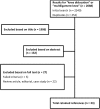Vascular and nerve injury after knee dislocation: a systematic review
- PMID: 24554457
- PMCID: PMC4117866
- DOI: 10.1007/s11999-014-3511-3
Vascular and nerve injury after knee dislocation: a systematic review
Abstract
Background: Vascular injury is a devastating complication of acute knee dislocation. However, there are wide discrepancies in the reported frequency of vascular injury after knee dislocations, as well as important differences among approaches for diagnosis of this potentially limb-threatening problem.
Questions/purposes: We determined (1) the frequency of vascular and neurologic injury after knee dislocation and whether it varied by the type of knee dislocation, (2) the frequency with which surgical intervention was performed for vascular injury in this setting, and (3) the frequency with which each imaging modality was used to detect vascular injury.
Methods: We searched the MEDLINE(®) literature database for studies in English that examined the clinical sequelae and diagnostic evaluation after knee dislocation. Vascular and nerve injury incidence after knee dislocation, surgical repair rate within vascular injury, and amputation rate after vascular injury were used to perform a meta-analysis. Other measures such as diagnostic modality used and the vessel injured after knee dislocation were also evaluated.
Results: We identified 862 patients with knee dislocations, of whom 171 sustained vascular injury, yielding a weighted frequency of 18%. The frequency of nerve injuries after knee dislocation was 25% (75 of 272). We found that 80% (134 of 160) of vascular injuries underwent repair, and 12% (22 of 134) of vascular injuries resulted in amputation. The Schenck and Kennedy knee dislocation classifications with the highest vascular injury prevalence were observed in knees that involved the ACL, PCL, and medial collateral liagment (KDIIIL) (32%) and posterior dislocation (25%), respectively. Selective angiography was the most frequently used diagnostic modality (61%, 14 of 23), followed by nonselective angiography and duplex ultrasonography (22%, five of 23), ankle-brachial index (17%, four of 23), and MR angiography (9%, two of 23).
Conclusions: This review enhances our understanding of the frequency of vascular injury and repair, amputation, and nerve injuries after knee dislocation. It also illustrates the lack of consensus among practitioners regarding the diagnostic and treatment algorithm for vascular injury. After pooling existing data on this topic, no outcomes-driven conclusions could be drawn regarding the ideal diagnostic modality or indications for surgical repair. In light of these findings and the morbidity associated with a missed diagnosis, clinicians should err on the side of caution in ruling out arterial injury.
Figures



References
Publication types
MeSH terms
LinkOut - more resources
Full Text Sources
Other Literature Sources
Medical

